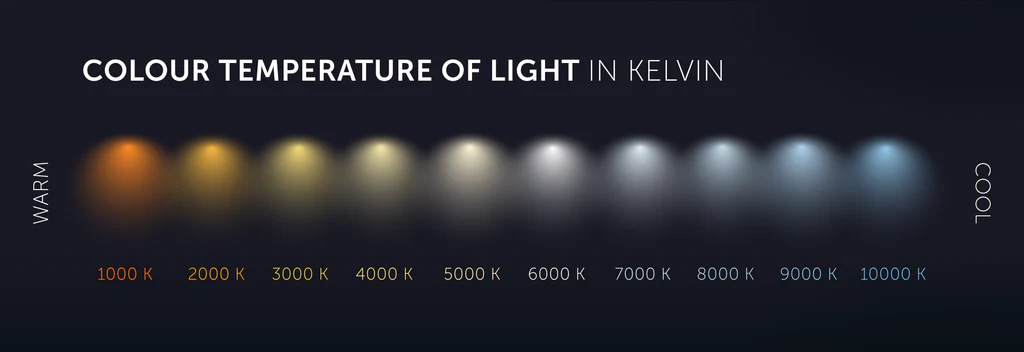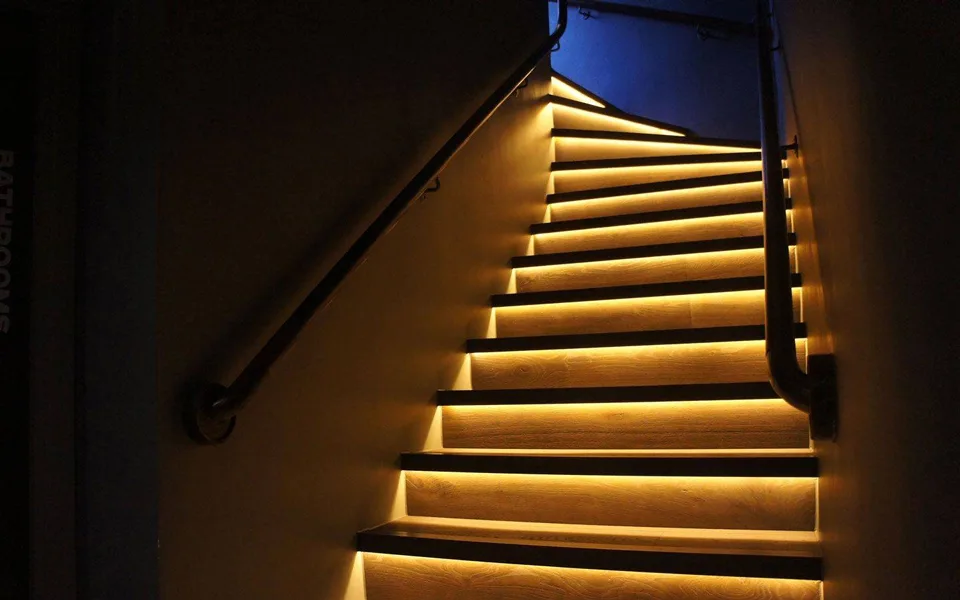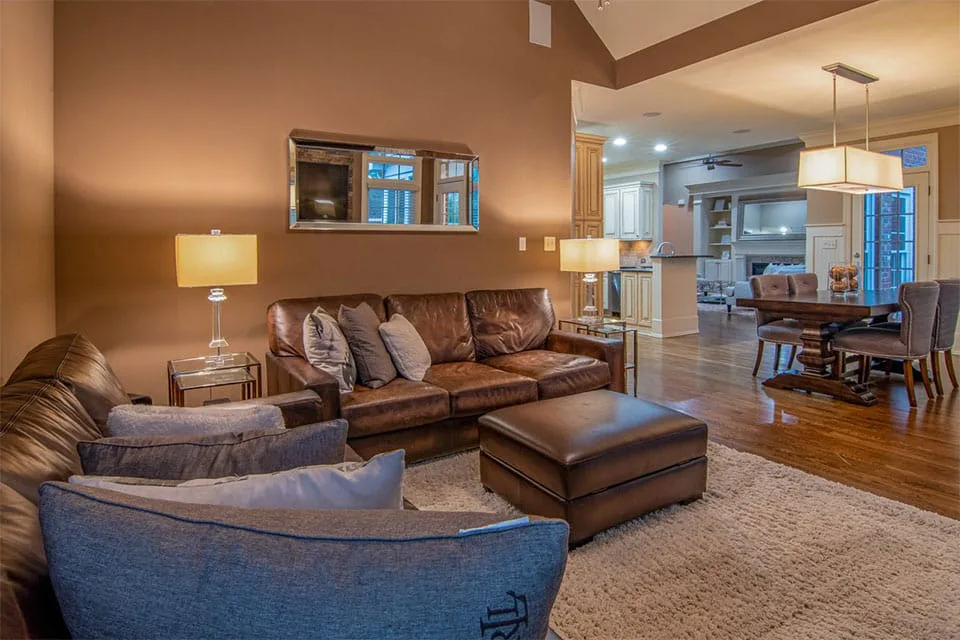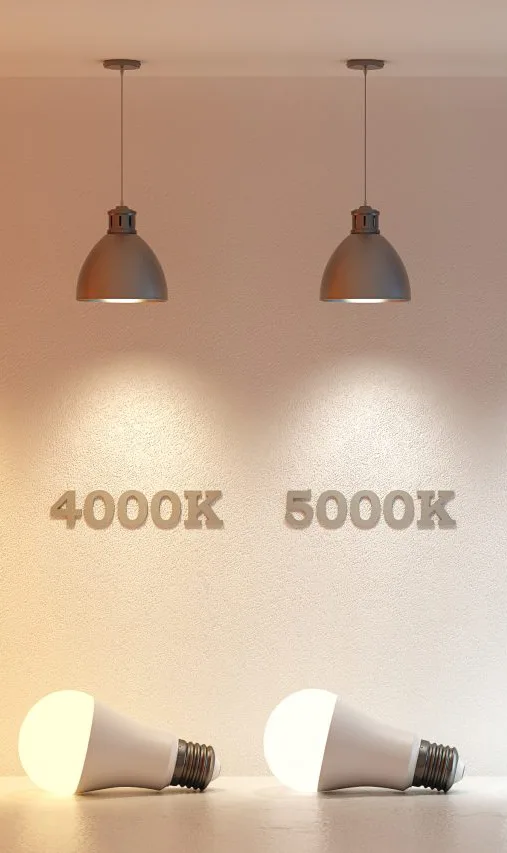
Lighting is an important aspect of a family home or commercial environment. It’s not about practicality, but rather the impact it has on the aesthetics and ambiance of a space. When it comes to choosing the right lighting for your space, even the slightest difference can have a significant impact. One such consideration is the color temperature of the LED lights. Two of the most common of the many available options are 2700K and 3000K lights. While these two colors are often thought of as “warm white,” there is indeed a noticeable difference in color between these two color temperatures.
2700K light looks warmer and has a more yellowish hue than 3000K. Soft white light has less yellow and cleaner, crisper colors than warm white light. For some people, deciding which color is more appropriate may not seem easy. In our opinion, there is no right or wrong way to choose 2700K or 3000K for a lighting project. It is subjective—a feeling or preference of the viewer.
The choice between 2700K and 3000K may seem like a numerical change, but for the business or homeowner looking for the perfect ambiance, it’s significant. Whether you’re illuminating a retail space, an office environment, or a hospitality setting, the choice between 2700K and 3000K will determine ambiance, productivity, and overall experience. In this article, we’ll delve into the intricacies of each option to help you make an informed decision based on your specific needs.
Definition of Kelvin and Correlated Color Temperature
Correlated Color Temperature (CCT) is a measure of the quality of white light. White light consists of a mixture of different wavelengths, and CCT describes the relative proportion of low-frequency reds and oranges to high-frequency blues and purples in any given white light. The variation in the ratio of different wavelengths gives us different types of white light, from “warm” light (rich in red and yellow wavelengths, as we see in our living room or cozy dining room) to “cool” light (rich in blue wavelengths, as we might see in the office or gym).

CCT provides us with a precise and quantifiable way to express the hue of white light in Kelvins (K). Kelvin is a scale that describes color temperature, ranging from 1,000 to 10,000. As a result, lights with different color temperatures have different characteristics; these include ambience, brightness, and appearance.
At 1000K, it reflects the warm glow of a candle flame. When the color temperature reaches 2000 K, it resembles the soft glow of a sunrise or sunset. In the 2000 K to 3000 K range, the light appears as an orange-white to yellowish-white color, also known as “warm white.” “Neutral white” refers to lights between 3100 and 4500 on the Kelvin scale, which emit a neutral white light with a slightly bluish tint.
The color temperature of your light can affect your mood, productivity, and even your health. Warm lights tend to create a relaxing and cozy environment and are suitable for living rooms or bedrooms, while cooler lights are thought to improve concentration, making them ideal for offices and study areas.
2700K: Warm White Like an Incandescent Bulb
A traditional incandescent bulb glows when the filament inside the bulb gets very hot and begins to emit light. At maximum brightness, the temperature of the filament is about 2700 Kelvin, resulting in a color temperature of 2700 K. It creates a very comfortable and warm environment. In a warm environment one feels very relaxed and calm. It is one of the most popular color temperatures chosen by strip light users for living rooms and bedrooms.
Simply put, a non-incandescent bulb with a color temperature of 2700K has a similar light color to an incandescent bulb. If you prefer the color of a traditional incandescent bulb, then 2700K is the color temperature you need.2700K provides a very comfortable and warm ambiance, making it a great choice for living rooms and bedrooms where you want to relax. Under the warm white light of 2700K, people feel very comfortable and relaxed while talking with friends or watching TV. Similarly, when you stay in your bedroom, 2700K light maintains a calm and peaceful atmosphere so you can fall asleep quickly.
Why does warm white light give you a feeling of relaxation and calm? This is because warm white light lacks blue light waves. The lack of blue light waves encourages our brain to produce melatonin, a natural hormone that creates calm and relaxation in the brain, allowing us to easily calm down and fall asleep.
The main advantage of 2700K lighting is its ability to create warm and pleasant spaces. However, it may not be the best choice for task-oriented areas, as warmer light reduces contrast and makes details harder to see.
3000K: A Softer Alternative
The term “warm white” refers to the color emitted by a light bulb. It is available in a variety of different models, of which the 2700K and 3000K lamps are just two. The 2700K and 3000K lamps are just two of them, as they resemble the warm white hue of the original incandescent bulb. In other words, they emit a warm light that is closer to yellow than blue.
Compared to 2700K, 3000K light is a slightly purer, neutral white. It has less of a yellow/orange tint, so it will look softer. If you have any halogen bulbs, they will most likely emit a 3000K light color. 3000K light is still warm, but slightly less yellow than 2700K light. It looks cleaner or sharper than 2700K. In other words, 3000K is closer to a neutral white than 2700K.
3000K light casts less yellow or reddish tones on objects. So, if you want your space to have a warmer but clearer or cleaner white color, you can choose a 3000K LED strip. The color presentation of your food is very important to the dining experience. You may not want to see all of your food in a yellowish color. In this sense, when choosing LED strips for your project, using 3000K soft white rather than 2700K may be a better choice for kitchens, dining rooms, and restaurants.
If you personally don’t like the color of 2700K incandescent bulbs, or if you’re looking for greater color acuity, then 3000K may well be the best choice for you. And by specifying a precise 3000K color temperature (no higher), you’re less likely to find the light too cold or harsh. 3000K is still in the “warm white” range of color temperatures, so you don’t have to worry about it being too blue, too intense, or too cold.
The advantage of 3000K lighting is that it provides clear, bright illumination, which helps to increase productivity and reduce eye strain. However, it may not be as comfortable as 2700K for relaxing environments and may be considered too cool for certain tastes.
The Difference Between 2700K and 3000K
The main difference between 2700K and 3000K is their color temperature and hue; 2700K is often referred to as “warm white” because of its yellow-orange hue, while 3000K is referred to as “soft white.”.

While there is not much difference between the two lamps on the Kelvin scale, their appearance is different. If you place 2700K and 3000K bulbs side by side, you’ll be able to tell the difference: 2700K provides a warmer, more yellowish light, while 3000K provides a cleaner, whiter light. This subtle change can change the character of a room.
To easily understand the comparison between 2700K and 3000K lighting, check out the table below:
| 2700K | 3000K | |
| Color | A warm white light with a distinctive orange and yellow overtone | A soft white light with a neutral and cooler overtone |
| Atmosphere | Cozy, inviting, and warm | Soft, warm, yet a bit more neutral |
| Brightness and Intensity | Low | High |
| CRI Measurement | Mostly 80-90 | Typically 80-95 |
| Blue Light Emission | Low | Slightly higher |
| Commercial Uses | Restaurants and libraries | Retail and office spaces |
| Residential Uses | Bedrooms, living areas, dining rooms | Bedrooms, living areas, dining rooms, kitchens |
2700K Warm White has an orange-yellow hue, while 3000K Soft White is cooler and more neutral in tone. The difference in these two color tones creates a unique ambiance, with the 2700K giving a warmer feel and the 3000K being softer and whiter.
2700K lights give off a glow similar to traditional incandescent lighting, adding a sense of comfort to the environment. 2700K differs from its close neighbor, 3000K, in its warmer, more relaxing tones, creating a more intimate feel that is perfect for private spaces such as living rooms, bedrooms, and dining rooms. Its subtle tones promote relaxation and comfort, making it a popular choice for hospitality and residential environments.
Emitting a softer glow than the warmer 2700K lighting, the 3000K variant features reduced orange and yellow tones designed to enhance ambience and functionality. It strikes the perfect balance between cozy and refreshing, making it ideal for retail displays, restaurants, hospitality environments, and residential spaces that require a softer glow. Whether decorating hospitality venues, retail environments, or office environments, 3000K lighting enhances spaces with its inviting glow, creating a warm and inviting atmosphere while ensuring optimal visibility.
However, LEDs with color temperatures of 2700K and 3000K can mix and work well together if they are not placed very close to each other. So, for a uniform look, if you are using 2700K lights for retro-style lighting in your kitchen, use 3000K LED strips under countertops or cabinets for a clearer, sharper white color. This will create the perfect blend of both temperatures, so it will enhance both practicality and aesthetics.
2700K vs. 3000K: Where Should I Use Them?
2700 Kelvin is the temperature at which the filament in a traditional incandescent light bulb begins to glow. This is the measurement of a yellowish bulb that simulates candlelight. These 2700K lamps have a yellow tint that makes things look more comfortable and natural. These lamps are suitable for the following activities or tasks:
- Enhance materials with natural shades such as wood or fabric.
- Dining room
- Lounge
- Bedrooms
- Living spaces
- Read a book with warm lighting to brighten the mood.
- Relaxing or watching TV

3000K lights still fall into the warm white category; therefore, the differences from 2700K are minimal. That said, you will notice the difference in the small details and how it affects the décor. Additionally, you will notice that it is more appropriate for your home if you have a modern design with light (or white) wall colors. In other words, a slightly lighter yellow light will illuminate the room in a different way, creating a more modern atmosphere.
3000K lights are better suited for playing or working in any environment that requires good detail recognition and a clearer line of sight for proper quality perception. Typically, 3000K lights are best suited for the following areas of your home:
- Bathrooms
- Dining room
- Office
- Kitchen
- Materials that reflect cool-colored surfaces such as glass and tile
- Hotel foyers
- Typically used for clean ambient light

Factors to Consider When Choosing 2700K or 3000K
When choosing 2700K or 3000K LED lighting, there are a few key aspects to consider to ensure that your choice fits your goals and environment. Here are some factors to consider:
Ambience and Mood
Consider the mood and ambiance you want for your space. 2700K lighting emits a warm, inviting glow that is perfect for cozy environments such as restaurants, boutiques, and hotel libraries. On the other hand, 3000K offers slightly cooler tones that provide a more energized atmosphere, suitable for task-oriented environments such as offices or retail spaces.
Function and Productivity
Evaluate the main activities taking place in your space. For tasks that require precise visibility and attention, such as reading, detailed work, or product displays, a cooler light temperature, such as 3000K, may be a better choice because it enhances focus and visual acuity. Conversely, if your business involves casual or social interactions, such as in a restaurant, lounge, or hospitality venue, warmer tones such as 2700K may be more beneficial because they create a welcoming atmosphere without harsh glare.
Color Rendering
Evaluate the impact of color rendering on your business. While both temperatures offer high color rendering indices, 2700K tends to render warm tones more vividly, which can enhance the appeal of certain products or decorative elements. Conversely, 3000K provides balanced color reproduction, which may be preferable in environments that require accurate color rendering, such as art galleries or retail displays.
Energy Efficiency
Consider energy efficiency and operating costs when choosing LED lighting options. While both 2700K and 3000K LED bulbs are energy efficient compared to traditional incandescent bulbs, slight variations in color temperature can affect perceived brightness and energy consumption. Typically, lower temperatures appear brighter and may consume more energy than higher temperatures. Evaluate your LED lighting needs as well as budget constraints to find a balance between energy efficiency and desired ambiance.
Customer Experience
Evaluate how LED lighting affects the overall customer experience within your organization.LED lighting plays a critical role in shaping perceptions of your brand, products, and services. Making the right choice between 2700K and 3000K can enhance the visual appeal of your merchandise, create an inviting atmosphere, and leave a lasting impression on your customers. Consider your target audience and the nature of your business when making this decision.
Don’t Overlook the Color Rendering Index

Previously, we briefly touched on the Color Rendering Index (CRI), a measurement of how light affects the way colors are rendered.CRI values range from 0 to 100, depending on how well the light produced matches a natural light source, such as the sun. For LED luminaires, a higher CRI means that they will render color more accurately to surrounding objects. Typically, a CRI range of 90 to 100 produces clear colors and is therefore rated as excellent.
Many people may find 2700K lamps to be too yellow or dull, not because of their color temperature, but because of their CRI value. Low CRI values (independent of color temperature) cause objects to appear faded and dull. Therefore, if you decide to rule out 2700K LED lamps based on previous experience, we recommend that you make sure that you really don’t like the color temperature and that it’s not its CRI value that’s the problem. Similarly, if you want to use 3000K to improve color accuracy and clarity, remember that a high CRI is just as important as changing the color temperature from 2700K to 3000K. A low CRI 3000K light source will remove most of the yellow and orange tints, but it will still not faithfully render the colors of objects. For example, if you choose to install 3000K lights in your bathroom to better see makeup colors, be sure to select the high CRI option, or you may not achieve the improved color accuracy you originally hoped for.
For this reason, it is critical to confirm the CRI value when purchasing your LED lights. The choice of color temperature will always depend on your personal preference, and the color temperature will only enhance the ambiance or atmosphere you want to create for the room. However, in all cases, the CRI value should be high, and if you are looking for the best CRI, you should set it between 80 and 100.
Do 2700K and 3000K Have Blue Light Hazard?
In today’s health-conscious environment, the health effects of blue light are becoming a growing concern. As smartphones, tablets, and other light-emitting screens become commonplace late at night, it’s affecting our ability to fall asleep and rest even more. Studies have shown that exposure to blue light can interfere with melatonin production, affecting sleep quality and relaxation. For this reason, the type, intensity, and duration of light exposure at bedtime are key considerations for optimal rest.

Generally speaking, all else being equal, 3000K will have a higher level of blue light than 2700K. Therefore, for those who are health conscious and wish to minimize exposure to blue light, 2700K is preferable to 3000K LEDs, which can cause increased alertness and difficulty falling asleep.
However, avoiding 3000K LEDs altogether is not necessary. First of all, the difference between 2700K and 3000K in terms of blue color content is certainly measurable, but not very significant. While there is a slight increase in blue light between 2700K and 3000K, it must be put into a broader context. In comparison, a typical smartphone screen has a color temperature of 6500K, indicating significant blue light emission. In addition, 3000K light is in the warm white spectrum, with only a slight increase in blue light compared to 2700K.
Second, in addition to color temperature, there are other factors that affect the degree of blue light hazard. For example, the brightness of the LED light, the distance between your eyes and the LED light source, and the exposure time can also have a significant impact.
Balancing color temperature with other factors such as intensity and exposure time is the key to mitigating blue light hazard. Therefore, judicious use of 2700K or 3000K LED lights can still be beneficial, especially when cooler, less yellow or orange tones are desired.
Dim to Warm and CCT Tunable: The Most Effective and Intelligent Solution
Dim to Warm is a dimming technology that brings out different shades of warm white. By adjusting the color temperature of these lights, you can achieve a variety of warm tones.
Dim-to-warm technology is very similar to the mechanism of dimmable incandescent bulbs. The only difference is that the light intensity of such bulbs is reduced, thus reducing the current. However, in LEDs with dimmable warming, the color temperature is reduced, resulting in warm white tones. In this technology, changing the color temperature from 3000K to 1800K produces various shades of white. The light with the highest color temperature has the brightest hue. When you dim the light, it reduces the current inside the chip. As a result, the temperature of the color drops and a warmer light is produced.
And the CCT tunable allows you to switch the color temperature as you choose. You can also choose tunable CCT LED lights to mimic the natural pattern of sunlight. The best part about these LED lights is that you can switch from 2700K to 6500K whenever possible, so you can use these lights in all aspects of your home without much thought. The freedom to change the temperature of the light color allows you to set any mood you want.
Dim to Warm
CCT Tunable
Dim to Warm and CCT Tunable are not the same. Dim to Warm offers only warm tones, while CCT Tunable offers all shades of white from warm to cool. However, adjustable whites give you more color-changing options than dim to white. This is the reason why they are also quite expensive as compared to dark to warm. Therefore, if you are on a budget, consider using them only in specific areas, which may be areas where you are unsure of the ideal light color temperature.
Conclusion
The light colors of 2700k and 3000k may not differ much on the Kelvin scale, but they do have subtle differences. 2700K is warmer, while 3000K is crisper and cooler. Subtle differences in light color may separate them, but in terms of the resulting color, it can make a big difference.
Lighting can completely change the look and, more importantly, the feel of a house. In fact, lighting conveys a certain hue to the elements of a room and creates more of an overall atmosphere than any physical object. In most cases, the color temperature of the lighting depends on personal preference. Some may prefer the look of 2700K, while others may prefer 3000K. That said, it’s important to know what you’re getting before you buy. We hope this article has made that clear.
SignliteLED is a China factory specializing in producing high-quality custom SMD LED strips and COB LED strips. If you need to buy an LED strip and its accessories, please contact us.
Related Posts
LED Lighting Color Temperature Comparison: 3000K vs. 4000K
LED Lighting Color Temperature Comparison: 4000K vs. 5000K






